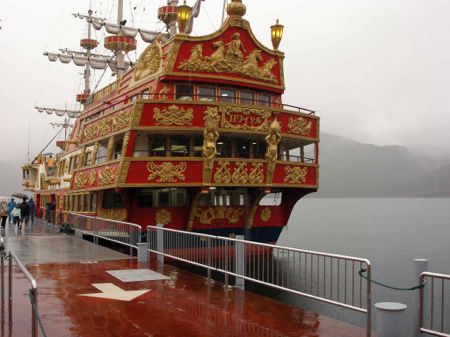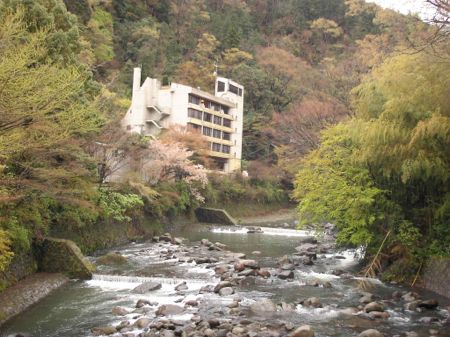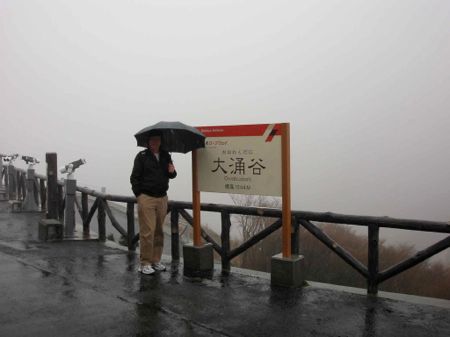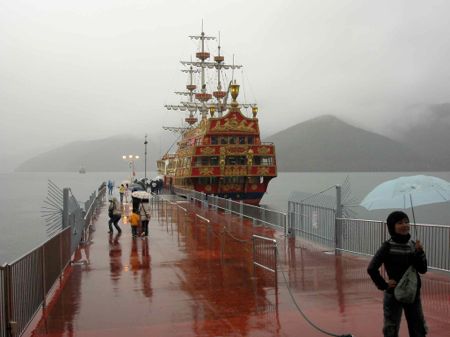Nagoya > Hakone

The next morning we awoke to be confronted by bleak drizzly weather. When ‘Er Indoors checked the weather forecast of The Mother’s Mobile it wasn’t promising. Seemingly, indoors was the place to be for the next twenty-four hours or so, with rain and wind forecast for Odawara, where’d we be alighting from the shinkansen on a day where the planned agenda included a lot of walking.
We discussed matters over breakfast, as you do in these situations, then headed upstairs to tackle the increasingly-difficult task of fitting everything back into the suitcase and adding the extra items acquired since yesterday morning.
We managed to stay dry by taking the underground route to the station, arriving in plenty of time despite an initial mild case of panic.
Standing on the platform I started to realise how many shinkansen services they fit into a day along the Tokaido corridor. The track next door to our platform had trains departing for Tokyo at 9:10, 9:19 and 9:27. Our train, also to Tokyo (though we were disembarking at Odawara) left at 9:22. in other words, four trains to the same destination leaving in a period of just under twenty minutes.
When we’d booked the day’s seats we’d been told that there were no window seats available (we’d landed Car 12 Seats 13 B&C) but, as it turned out, there was no one in 13A and since no one arrived to claim it we managed to end up with the window seat anyway since the train was travelling express from Nagoya to Odawara, solving a slight luggage problem on a crowded train.
While there are the predictable overhead racks for hand luggage, on most shinkansen there isn’t a designated space for large luggage items (hardly surprising, since making those provisions would create space constraints in other ways) and, once the handy places most people use to stow such items have been filled there isn’t much choice but to squeeze the item into the space between your legs and the seat in front of you.
Fortunately, they’ve allowed plenty of leg room.
As it was, I moved to 13A, Madam occupied 13B and the suitcase had the whole of the space in front of 13C to itself.
Despite the acquisition of the window seat there wasn’t much to see in a landscape misty wet with rain, so I devoted the time to writing up the previous day’s leg of the journey
Outside, the landscape was pretty much like it had been last time we were on the coastal plain, though I noticed a number of structures that seemed to be greenhouses.
Surprisingly, there also seemed to be a little more forest than usual. before we moved back into the familiar urban sprawl just before we reached the bridge across the brackish Hamana Lake, a drowned river valley with its mouth blocked by sand banks.
There were, predictably, plenty of shinkansen heading past in the opposite direction. One minute you’re looking across the landscape, then you’re suddenly hit by a jolt against the window as a silver and blue blur obscures the view, which reappears almost before you’ve had time to blink.
We were seated on the starboard side of the train, but away to the left we had views across to the South Alps on the left, as ‘Er Indoors scanned that side hoping for a glimpse of Mount Fuji. Though spring had well and truly sprung on the lowlands there was plenty of snow on the peaks.
We passed extensive tea plantings on slopes where rice cultivation would have been out of the question, as well as on flat ground. It was probably a case of totally-misguided optimism, but it seemed that the weather away to our right was lifting though there was still heavy cloud over the mountains away to our left.
Still, there was plenty to ponder.
Passing through another urban area I was surprised to see a building that looked awfully like a Christian cathedral towering above the surrounding buildings. I think that might have been in Shizuoka, though it’s impossible to tell for sure. There are very few stations on this section of the shinkansen line and, even if there were, from a train travelling at express speed you’d be flat out reading the signs as you whiz past.
The other standout, apart from the odd cathedral-like structure, was the increasing number of tunnels as we headed towards Atami, a coastal hot spring resort that’s been attracting travellers since the 8th century.
We’d just alighted from the train in Odawara and were looking for the most appropriate exit when a southbound shinkansen rocketed through the station, showing how fast 200 kilometres per hour is when you’re standing nearby. It was literally a case of now you see it, now you don’t.
‘Er Indoors lead us off the platform about thirty seconds later, single-mindedly heading off in search of the window where she could pick up a pair of two-day Hakone passes and leaving Yours Truly struggling down a flight of stairs juggling the suitcase. About half way down I felt a twinge in my right leg, which didn’t help the mobility on a day when we’d planned on doing plenty of walking.
Once we’d bought the passes, it was onto a local train, which carried us to Hakone-Yumoto, and then catching a bus to the night’s accommodation the Quatre Saisons Hotel at Tonosawa.

The bus dropped us off in a car park about a hundred metres down the road from the hotel, leaving us with a rather scary walk along the side of a very narrow winding road with plenty of traffic passing in both directions. It was about eleven when we dropped the luggage off and walked back to the bus stop in the rain as cars rolled past in alarming proximity.
I don’t mind sharing the road with the odd car while I’m walking, but I’d prefer to have the cars passing by somewhere beyond an arm’s reach.
Back in Hakone-Yumoto we caught the train to Gora, an amazing zigzag ride with switch-backs galore as we headed through the mist and rain up into the mountains. The views on a fine, sunny day would probably have been quite spectacular but the journey through the mist created a mood of primeval mystery.
From Gora we took the Hakone Tozan cable car up the hill to Sounzan, missing the chance to investigate what appeared to be a Swiss restaurant just down the road from the station.
The next stage of the journey, the main aim of which was to get a view of Mount Fuji, involved taking the Hakone rope-way which would eventually deposit us on the shores of Lake Ashi. We decided to stop for lunch at one of the intermediate stations on the rope-way, Owakudani (allegedly one of the top spots for visiting Mount Fuji, but a glance at the accompanying photo shows that we had about as much chance of viewing the mystic mountain as a wheelchair-bound double amputee has of taking out the triple jump gold medal at the Beijing Olympics.

Our plans, in other words, were never going to get off the ground.
On the other hand it was lunchtime, and while Madam decided that she fancied a fried sweet potato from the lobby. I leaned in favour of a Japanese curry from the restaurant upstairs so I set off in solo mode to find my own lunch, a thousand-yen note in hand.
Once seated in the restaurant, I learned that I could have the curry by itself for 950 yen or with egg for 950. Opting in favour of the egg, I was rewarded with a plate of curry and rice accompanied by a black-shelled soft boiled egg which I peeled and incorporated into the curry and rice mixture. I don’t know if that’s the correct approach, but, in the absence of expert guidance regarding the correct protocol, that was what I did.
Downstairs, informing ‘Er Indoors about my action, I was bemused to learn consumption of the seven year egg had added seven years to my life span. She pointed to handy packs of five similar eggs, but I decided that should I purchase an extra thirty-five years on Hughesy’s life span would probably be too much for the superannuation fund to handle.
An extra seven years would have to do.

Back on the rope-way we set off once again into the mist, finishing at Togendai on Lake Ashi, where we boarded what appeared to be a replica of a pirate ship for a sight-seeing cruise to Moto-Hakone. The cruise supposedly offers one of the best Fuji-viewing options, but we were flat out seeing past the shores of the lake and, from Moto-Hakone it was impossible to see the other end of the lake, let alone any majestic mountain that might be lurking above it.
In Moto-Hakone we decided that discretion and a chance to get warm was the better part of valour, so we boarded a bus that would take us straight back to the hotel, braved the traffic between the bus stop and the front door, and checked in.
When we entered the room I’d, not to put too fine a point on it, just about had enough for the day.
Then we opened the curtains, and the view that greeted us was absolutely spectacular. The hotel is situated right on a bend in the stream that flows down to Hakone-Yumoto and, from the rooms on the stream side, you have views up and down the steep-sided, heavily-forested river valley.
I would have been quite happy to spend the next hour or so just sitting down and gazing out the window at the views while the camera battery recovered from the day’s ordeal, but ‘Er Indoors was particularly insistent that I take a trip downstairs to the onsen (hot-spring spa, which was, basically, the reason for the hotel’s existence), because it would be good for the muscle that had been troubling my right leg, and, eventually, I realized that I might as well surrender to the inevitable and traipsed off downstairs.
Under different circumstances I could probably have spent longer soaking in the warm water, which admittedly does wonders for tired muscles, but the siren song of the view from an upstairs window proved much stronger than the solitary enjoyment of a giant-sized bathtub (a pleasure that could have been interrupted at any time by the arrival of other guests) so I emerged after ten minutes.
All up the onsen-visit had taken about twenty minutes out of premium canyon-gazing time and I had barely settled back into a relaxed gaze across the stream before a phone call alerted us that our evening meal - four or five courses in classic French style - awaited us.
The bottle of red (Cuvee Quatre Saisons, no less) disappointed on first taste but improved considerably:
(a) with breathing (as a red wine should), or
(b) as the level lowered.
Personally I tend to ascribe the improvement to the effects of oxygen on the contents of the bottle rather than the effects of the contents of the bottle on the drinker, but your mileage might vary.
Back upstairs, ‘Er Indoors attended to various administrative matters while I looked out across the dark stream with the iPod and a can of Asahi Super Dry for company.

